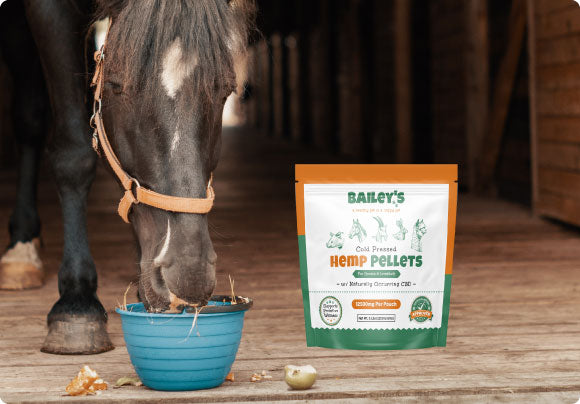Piebald Horse: Unique Coat Patterns and Characteristics

The piebald horse is a captivating equine with its distinctive coat patterns. These horses have fascinated horse enthusiasts for centuries. This article will illuminate the world of piebald horses, exploring their unique characteristics, genetics, necessary care, and their presence in popular culture. So, let's dive right in and understand what makes piebald horses so special.
With the help of Bailey’s CBD, we will explore the importance of safe treats and foods for horses.

Image: A piebald horse grazes in a field with vast countryside in the background.
Understanding the Piebald Horse
Defining the Piebald Coat
Piebald is a term used to describe a horse with a coat pattern that consists of large patches of white and another color, usually black or brown. The white patches can be irregularly shaped and are randomly distributed across the horse's body. These distinct markings differentiate piebald horses from other coat patterns like skewbald or tobiano.
One interesting fact about piebald horses is that their unique coat pattern is the result of a genetic mutation. This mutation affects the distribution of pigment-producing cells in the skin, leading to the characteristic patches of white and other colors. Despite being considered a color pattern, piebald is a term that describes the distribution of colors on the horse's coat, rather than a specific color itself.
RELATED ARTICLE: Learn More About Other Horse Breeds
History and Origin of Piebald Horses
The history and origin of piebald horses date back centuries. They can be traced back to ancient times, when they were depicted in cave paintings. Piebald horses were highly regarded by various cultures, including the Native Americans and the Celts. These striking animals have captivated the human imagination for generations, holding a special place in folklore and mythology.
In medieval Europe, piebald horses were often associated with nobility and were favored as mounts for knights and royalty. Their eye-catching appearance made them stand out on the battlefield and in tournaments, symbolizing power and prestige. The popularity of piebald horses continued to grow throughout history, with their distinctive coat pattern becoming a symbol of beauty and elegance.
🌟 Related Equine Products 🌟

CBD Oil For Horses
Experience natural relief and enhanced wellness for your horse with Bailey's Vet-Crafted CBD Oil featuring a veterinary dosage chart.
Shop Bailey's Vet-Crafted CBD Oil For Horses
CBD Pellets For Horses
Provide your horse with the natural benefits of CBD in a convenient pellet form with Bailey's Vet-Crafted CBD Pellets.
Shop Bailey's Vet-Crafted CBD Pellets For HorsesCharacteristics of Piebald Horses
Physical Traits
Piebald horses exhibit a wide range of physical traits. Along with their distinctive coat pattern, they often have unique facial markings, such as blazes or bald faces. Some may have one blue eye, adding to their allure. Additionally, piebalds can come in various sizes and conformations, making them suitable for a wide array of disciplines.
One fascinating aspect of piebald horses is the genetic basis for their coat pattern. The piebald coloring is caused by a combination of specific genes that result in the characteristic patches of white and another color. This genetic variation adds an intriguing layer to the beauty of these horses, as each piebald's coat pattern is unique and can vary widely.
RELATED ARTICLE: Learn and Essential Tips for a Balanced Diet 🐴
Temperament and Personality
Beyond their striking appearance, piebald horses are known for their friendly and gentle temperament. They often possess a kind and willing nature, making them popular as riding and companion animals. Their calm demeanor and willingness to work contribute to their versatility in equestrian activities.
Many owners and riders of piebald horses appreciate not only their physical attributes but also their intelligence and adaptability. Piebalds are often quick learners and can excel in various training programs, from dressage to trail riding. Their adaptability to different environments and tasks makes them sought after in the equine world, where versatility is highly valued.
The Genetics Behind Piebaldism
How Piebaldism is Inherited
Piebaldism is a fascinating genetic trait that showcases the intricate interplay of genes controlling pigmentation. The unique coat pattern of piebald horses is a result of specific genetic variations that can be inherited through complex mechanisms. In most cases, piebaldism is passed down from one or both parents, with the inheritance pattern exhibiting variability. When two piebald horses are bred together, the chances of producing a piebald offspring significantly increase, highlighting the hereditary nature of this striking trait.
Furthermore, the genetics of piebaldism extend beyond mere aesthetics, delving into the realm of inheritance patterns and gene expression. Researchers continue to explore the underlying genetic mechanisms that govern piebaldism, shedding light on the intricate processes that dictate coat coloration in horses. By unraveling the mysteries of piebaldism at a molecular level, scientists aim to deepen our understanding of genetic inheritance and its implications on phenotypic traits.
Health Implications of Piebaldism
While the piebald coat pattern itself may not directly impact the health of horses, certain genetic factors associated with piebaldism can give rise to specific health conditions. One notable example is overolethal white syndrome, a genetic disorder that predominantly affects overo piebald horses. Breeders and veterinarians work diligently to identify and mitigate the risk of such hereditary diseases through meticulous selection practices and genetic testing. By prioritizing the health and well-being of horses, responsible breeders play a crucial role in safeguarding against genetic disorders linked to piebaldism.
📚 Related Article: CBD Education for Horses
How to Give Your Horse CBD Oil
Learn the best methods for administering CBD oil to your horse. Discover tips and tricks to ensure your friend gets the full benefits of CBD. 🐾💧
Read More About CBD for Horses HereCaring for a Piebald Horse
Nutrition and Diet
Proper nutrition is essential for every horse, and piebalds are no exception. They have similar dietary requirements as other equines, needing a well-balanced diet consisting of hay or pasture forage, supplemented with quality grains and appropriate minerals. However, it is essential to consult with a veterinarian or equine nutritionist to tailor the diet to the individual horse's needs.
When it comes to feeding a piebald horse, it's important to consider any specific health conditions or dietary restrictions they may have. Some piebalds may be more prone to certain ailments, such as insulin resistance or metabolic issues, which can impact their dietary needs. Monitoring their weight and overall condition regularly can help ensure they are receiving the proper nutrition.
Grooming and Maintenance
Grooming piebald horses is not significantly different from grooming other horses. Regular brushing, hoof care, and dental checks are vital for maintaining their overall health and appearance. Paying particular attention to the white patches on their coat can be helpful, as they may be more susceptible to sunburn or skin conditions.
Additionally, incorporating regular exercise into a piebald horse's routine can help improve their muscle tone and overall well-being. Engaging in activities such as riding, lunging, or turnout can not only keep them physically fit but also provide mental stimulation and prevent boredom. It's important to strike a balance between exercise and rest to ensure the horse remains healthy and happy.
Piebald Horses in Popular Culture
Piebald Horses in Literature and Film
Piebald horses have made appearances in various literary works and films, captivating audiences with their striking presence. From the beloved piebald mare in "Black Beauty" to the magical Pegasus in "Clash of the Titans," these horses have played integral roles in storytelling, portraying beauty, strength, and grace.

Image: Two piebald horses grazing in a field with a few houses in the distance.
One of the most iconic piebald horses in literature is Hwin from C.S. Lewis's "The Horse and His Boy." Hwin is a talking mare with a piebald coat who embarks on a thrilling adventure, showcasing not only her physical beauty but also her intelligence and courage. In the world of film, the piebald horse Maximus in Disney's "Tangled" wins the hearts of viewers with his endearing personality and loyalty to Rapunzel.
Famous Piebald Horses in History
Throughout history, certain piebald horses have gained recognition for their exceptional qualities and achievements. For example, Captain Moore's piebald charger, Copenhagen, was a symbol of valor and loyalty during the Battle of Waterloo. These remarkable horses have left an indelible mark on history, reminding us of the timeless appeal of piebalds.
Another notable piebald horse from history is Pie, the mount of Sir Thomas Fairfax during the English Civil War. Pie was renowned for his speed and agility on the battlefield, carrying Fairfax to numerous victories. The sight of Pie's distinctive coat amidst the chaos of war became a symbol of hope and inspiration for Fairfax's troops.
As we come to the end of our exploration of piebald horses, we have gained an appreciation for their unique coat patterns, characteristics, and their place in human culture. Whether in folklore, literature, or real life, piebald horses are undeniably captivating. So, next time you come across a piebald horse, take a moment to admire its beauty and the rich history it embodies.
Conclusion
In conclusion, piebald horses are more than just horses with distinct coat patterns. They embody a sense of beauty, history, and curiosity. From their ancient origins to their presence in popular culture, piebald horses continue to captivate horse enthusiasts around the world. Whether you are drawn to their striking appearance or impressed by their friendly temperament, piebald horses are truly remarkable creatures that leave a lasting impression. If you happen to have a piebald horse or another equine friend, don’t forget to contact Bailey’s CBD to better care for their well-being and health. So, take a moment to appreciate the unique essence of these magnificent equines - the piebald horses.These products have not been evaluated by the FDA and are not intended to diagnose, treat, cure, or prevent any disease.












